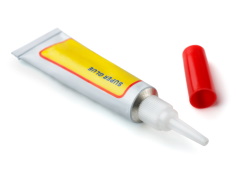Features
Stuck in the middle with glue
Date: 2020-02-28 15:30:48.0
Author: Jon Evans

Superglue.
Photo: Coprid/Shutterstock.
Glue comes in many different varieties for many different applications, from the glue on sticky notes to superglue, but they are all generally derived from chemicals extracted from fossil fuels. That could soon change, though, thanks to the efforts of scientists investigating various ways to produce glues and adhesives from plant-based materials.
The most straightforward approach is to replace the fossil fuel chemicals currently used to produce glues and adhesives with plant-based alternatives. For example, several research groups are working on producing glues from plant-derived tannins, as a replacement for the fossil fuel-derived phenols currently used in glue production.
Tannins can be extracted from tree bark, and so research groups in several countries are developing novel ways to extract tannins from the huge amounts of waste bark produced by their timber industries, with the specific aim of using these tannins to produce glue. Researchers at the VTT Technical Research Centre of Finland are developing ways to extract tannins from Finnish softwood bark, while researchers at Bern University of Applied Sciences in Biel, Switzerland, are extracting tannins from native Swiss conifers.
Another waste material from the timber industry that is being investigated as a source of chemicals for glue production is lignin. Thomas Epps and his colleagues at the University of Delaware in the US developed a catalytic method for breaking down lignin from poplar wood to yield two aromatic compounds, 4-propylsyringol and 4-propylguaiacol. They then used these compounds to replace one of the main components of an acrylate-based pressure sensitive adhesive (PSA) that is usually derived from fossil fuels.
PSAs are used to produce sticky tapes and labels, and Epps and his colleagues found that their bio-based version worked just as well as commercial sticky tapes and labels. As they reported in a paper in ACS Central Science, this was particularly impressive because commercial sticky tapes and labels often contain additional tackifiers to enhance adhesion, which their bio-based version lacked.
Now, an international team of scientists, led by Orlando Rojas at Aalto University in Finland, has shown that plant-derived material can also afford completely different approaches to adhesion. In this, their inspiration came not from conventional chemical glues, but rather from geckos and their impressive ability to stick to walls.
Conventional glues stick things by forming covalent bonds as they dry, and they tend to stick with the same strength in every direction. In contract, geckos stick to walls via rows of small, hair-like ridges on their feet, which establish various attractive forces, including van der Waal’s forces and capillary forces, with the surface they are walking on. While weaker than covalent bonds, these forces are still sufficient to stick geckos to walls, and are much easier to break and reform, allowing geckos to walk up those walls. In part, this is because these forces tend to be stronger in certain directions than others.
As they report in a paper in Advanced Materials, Rojas and his colleagues were able to replicate the ridges on geckos’ feet with cellulose nanocrystals (CNCs), thereby also replicating their stickiness. To do this, they simply deposit an aqueous dispersion of CNCs on a surface, place another surface on top and then allow the CNCs to dry. As they dry, the CNCs naturally come together to form separate rows, in which all the CNCs are all aligned in the same direction. This generates capillary forces and van der Waal’s forces that stick the CNCs to each other and to the top and bottom surfaces, just like gecko feet.
When Rojas and his colleagues tried this with two glass slides, they found the CNCs could stick the slides together with enough strength to hold a 90kg weight, making them as strong as superglue, but only in one direction. The two slides were easily separated when a small force was applied at right angles to them.
“The ability to hold this amount of weight with just a few drops is huge, especially from a natural plant-based solution,” said team member Blaise Tardy from Aalto University. At the moment, this CNC ‘glue’ takes quite a long time to dry, up to six hours, but the researchers are exploring various ways to speed this up, such as by applying heat and utilizing faster evaporating solvents.
The views represented here are solely those of the author and do not necessarily represent those of John Wiley and Sons, Ltd. or of the SCI.
Displaying 2 keywords used to tag this article:
- DG6582 Mens Moncler Down Jackets Gr
- Jules Audemars-Australia Best Quali
